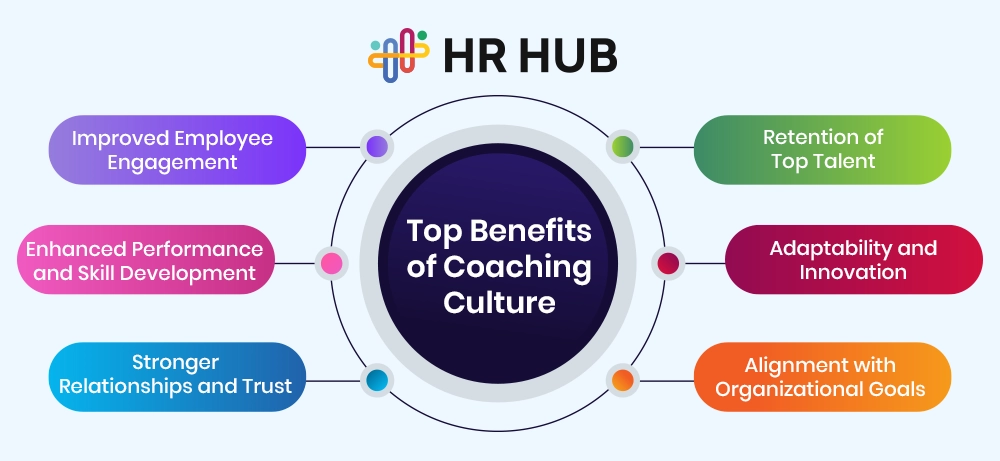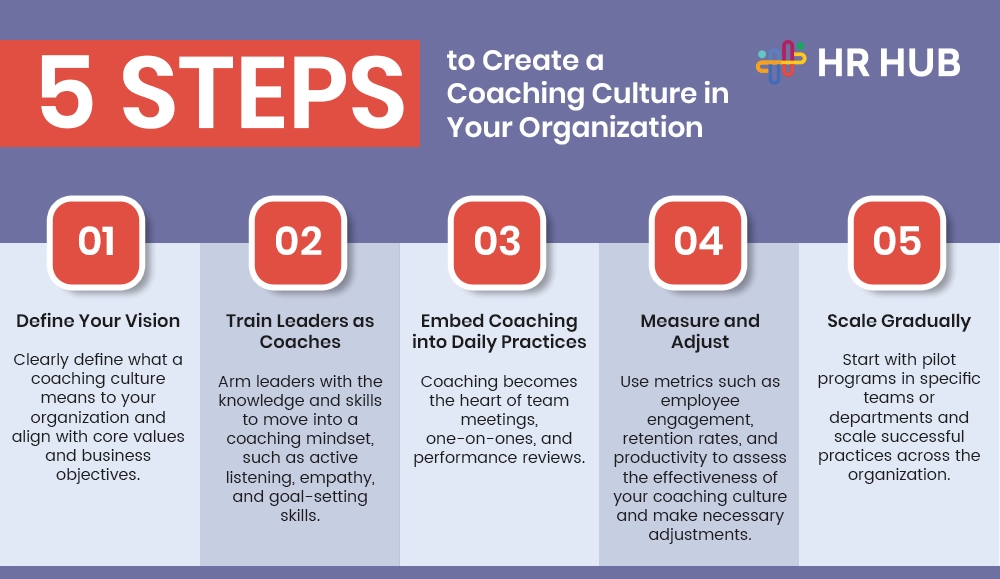In the modern, fast-moving workplace, top-down leadership fails to strengthen collaboration, innovation, and employee satisfaction.
It becomes difficult for managers to:
- Involve their teams.
- Link personal goals to organizational goals.
- Deliver feedback that will stimulate improvement by employees.
Employees may feel estranged, devalued, and neglected in their professional development.
Leadership as coaching — is an empowering transformation of practice in which leaders coach and guide to enable people to bring out the best in themselves. That, however, does not mean a culture of directive leadership shifts easily to become one centered on coaching. Organizations require strategies, HR management tools, and commitment to achieve such a shift.
What Is Coaching Culture?
A coaching culture is one in which coaching becomes a core organizational practice, part of daily interactions, processes, and leadership approaches.
Rather than annual reviews or isolated feedback sessions, coaching becomes an ongoing, collaborative, and empowering experience for all employees.
What are the Benefits of a Coaching Culture?

A coaching culture brings considerable advantages to the individual and the organization, deeply affecting performance, employee satisfaction, and organizational success. Now, let's dig a bit deeper into the most critical benefits:
Improved Employee Engagement
- Employees who are listened to and supported are more emotionally invested in their work. An open, honest coaching culture promotes feedback as frequently constructive, not just annual review feedback.
- Engaged employees take more responsibility for their jobs, take proactive steps to solve problems, and are more mission-aligned.

Enhanced Performance and Skill Development
- Coaching enables employees to focus on continuous improvement, leveraging strengths and improving weaknesses. This personal development contributes to higher performance levels.
- Employees can set realistic goals with definite measures and track progress, thus increasing productivity. An organization with effective coaching sees 14% higher productivity than one without such practice.
Stronger Relationships and Trust
- A coaching culture is a foundation that promotes transparency and communication, two pillars of building trust. The bond of such leadership and organizational culture grows stronger when employees realize leaders are interested in their growth and success.
- Trustful team relationships will offer better teamwork, problem-solving capabilities, and synergies, enabling the team to surmount problems and function effectively. Leaders, by their example in displaying coaching behaviors, lead by example and can further create this value within their teams.
Retention of Top Talent
- High performers will be likelier to stay with an organization that invests in their growth. A coaching culture demonstrates an organization is serious about an employee's career development, saving on turnover.
- The more an employee is engaged and supported in his work, the more that employee will be retained. It saves the organization time and money to recruit and train new staff. Companies with a coaching culture have 50% less turnover than their counterparts.
Adaptability and Innovation
- Fostering a culture of coaching promotes adaptability in rapidly changing business environments. An employee who is equipped and empowered with support is ready for change.
- Coaching’s leadership and organizational culture cultures drive innovation by allowing employees to make proposals, take risks, and think creatively. Feedback and collaborative problem-solving drive this innovation, strengthening an organization's competitive ability and capability to compete and thrive in the ever-changing marketplace.
Alignment with Organizational Goals
- The coaching process aligns employees' personal goals with the organization's greater mission and vision. Leaders serve as guides who help employees understand how their contributions relate to the company's success.
- Shared purpose results from such an alignment, and everyone works towards common goals. Organizational cohesiveness is also improved through it, and employees realize their contribution to the larger picture.
Strategies for Nurturing a Coaching Culture in Your Organization
Creating a coaching culture demands strategic support to penetrate the organization fully. The strategies for nurturing such a culture follow:
Establish Feedback Procedures
- Create structured feedback loops: Develop formal systems to keep the feedback going around the clock. For example, develop quarterly performance reviews, regular one-on-ones, or 360-degree feedback systems to make them feel supported and always keep in touch with their performance, not only annually.
- Encourage candid, constructive feedback: Train leaders to deliver feedback that identifies improvement areas and celebrates successes. Feedback should be actionable, clear, and motivating so that employees can work towards improvements.
Support and Accountability
- Set clear expectations about leadership: Coaching should become a primary leadership responsibility, and leaders should be armed with skills, tools, and support for effective coaching. Coaching can be an integral part of leader performance planning.
- Hold them accountable: Establish accountability systems that regularly hold leaders accountable for reporting on activities around coaching. Recognize those who excel in coaching roles, indicating that coaching is a valued role.
Invest in Coaching Development
- Provide training and resources: Implement formal training courses where leaders learn the coaching fundamentals in areas such as active listening, emotional intelligence, goal setting, and giving constructive feedback. Coaching programs can be done in-house or in partnership with professional coaching organizations.
- Encourage ongoing learning: Engage the leaders in constant professional development that would keep the focus of the coaching at the front lines of leadership culture practices through mentorship, certifications, and communities of practice.
Celebrate and Recognize Coaching Success
- Publicly celebrate coaching achievements: Recognize leaders and teams demonstrating outstanding coaching efforts. Create awards or recognition programs to highlight coaching excellence.
- Share success stories: Regularly share success stories of employees or leaders who have benefited from coaching. This reinforces the value of coaching and motivates others to participate in the culture.
Foster a Growth Mindset
- Promote learning and development: Provide constant opportunities for the growth and development of employees through their work and in the organization. Encourage them to strive for feedback, challenge themselves, and learn from successes and failures.
- Emphasize continuous improvement: Further position mistakes as learning opportunities. Encourage the teams to embrace change and iterate over ideas- that is, continually improve. Such mindsets encourage resilience and persistence.
5 Steps to Create a Coaching Culture in Your Organization

How to Overcome the Challenges of Creating a Coaching Culture?
Let’s explore the challenges and their solutions for creating a coaching culture in your organization.
Challenge: Resistance to Change
- Solution: Now, overcome resistance by clearly explaining the benefits of a coaching culture and including employees in this transition process, using examples or case studies of other organizations where corporate culture and leadership are perceived as successful.
- Involve employees in devising the coaching culture by encouraging their feedback concerns and allowing them to have a say in the process.
Challenge: Lack of Coaching Skills
- Solution: Provide comprehensive training programs to help leaders develop core coaching competencies. Ongoing learning should be provided in workshops, seminars, and peer coaching to build and refine those skills continuously.
- New leaders should be paired with mentors who can guide them through their coaching journey, creating an organizational culture and leadership of mentorship alongside coaching.
Challenge: Time Constraints
- Solution: Coordinating coaching with daily workflow tasks, such as conducting team meetings, project planning sessions, and one-on-ones. Coaching can then become an organic workflow element rather than added on.
- Make coaching conversations shorter and more focused (10–15 minutes) to work around leaders' and employees' busy schedules yet deliver strong value.
Challenge: Measuring Success
- Solution: Establish clear KPIs and monitor engagement, performance improvement, and retention metrics. This is measured by quantitative data (like productivity metrics) and qualitative data (like employee feedback) when assessing success.
- Periodically review the effectiveness of the coaching program and adjust the strategy to maintain continuous improvement.
Building the Future Together
It is not a one-night phenomenon but a journey of continuous improvement and collective commitment to developing a coaching culture. Organizations embracing leadership as coaching free their teams to their maximum potential and create an environment of trust, growth, and innovation. This shift towards a coaching culture is possible and deeply rewarding with the right strategies and focus on people.
At HR HUB, we believe in enabling leaders to create a coaching mentality. Our platform provides tools and resources to enable organizations to combine coaching into all aspects of their HR practices. Are you ready to leap? Start building your coaching culture today!






